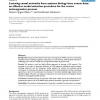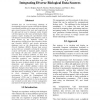350 search results - page 54 / 70 » A Gene Network Model for Developing Cell Lineages |
BMCBI
2010
13 years 9 months ago
2010
Background: Phenomenological information about regulatory interactions is frequently available and can be readily converted to Boolean models. Fully quantitative models, on the ot...
BMCBI
2007
13 years 8 months ago
2007
Background: Causal networks based on the vector autoregressive (VAR) process are a promising statistical tool for modeling regulatory interactions in a cell. However, learning the...
JCNS
2002
13 years 8 months ago
2002
We present a reduction of a large-scale network model of visual cortex developed by McLaughlin, Shapley, Shelley, and Wielaard. The reduction is from many integrate-and-fire neuron...
CSB
2005
IEEE
14 years 2 months ago
2005
IEEE
Scientists face an ever-increasing challenge in investigating biological systems with high throughput experimental methods such as mass spectrometry and gene arrays because of the...
BMCBI
2007
13 years 9 months ago
2007
Background: Systematic, high-throughput studies of mouse phenotypes have been hampered by the inability to analyze individual animal data from a multitude of sources in an integra...


